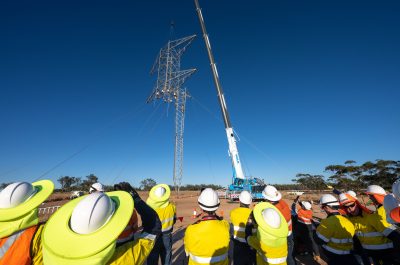Fact Check: Rewiring the nation
Energy policy has been front and centre of Australia’s post-pandemic economic recovery, with a battle of transmission policies taking the headlines from gas plans during budget week. Lots of claims were made by both sides of politics about what this means for customers, but what are the facts? We take a look.
Coalition – Fast tracking priority transmission projects
The Budget’s $14 billion in new and accelerated infrastructure projects, included Up to $250 million to accelerate major transmission projects such as Marinus Link, Project EnergyConnect and VNI West to the next stage announced by Energy Minister, Angus Taylor.
However, we have little detail about how this funding will be applied to each of the three projects. TasNetworks welcomed the funding and committed to working with the Tasmanian and Federal governments to progress the project through the design and approvals phase.
The Minister’s announcement also mentioned the Government’s existing support for HumeLink and the Queensland New South Wales (QNI) Interconnector. This may be a sign that the new funding will take the form of underwriting arrangements.
Labor – Rewiring the Nation
Labor’s proposed Rewiring the Nation Corporation is central to the Opposition’s commitment to upgrade our electricity transmission system and create jobs.
Nationalised electricity grid vs Fixing the regulations
“By establishing the Rewiring the Nation Corporation (RNC) and keeping it in public hands as a government-owned entity, Labor will ensure the grid is rebuilt at the best price possible.” Leader of the Opposition, Anthony Albanese
The proposed Rewiring of the Nation Corporation could be seen as a proposal to re-nationalise parts the electricity grid.
There’s no doubt employing government-backed debt to help finance the multi-billion-dollar projects proposed in the Integrated System Plan could, in theory, lower the financing costs for these multi-billion–dollar investments. But – and it’s a big but – there are a few key unknowns here:
- How would the RNC proposal tie in with the current regulatory framework?
- Would the RNC plan solve the underlying policy and regulatory issues that are causing the lack of transmission investment?
- What is the actual deal here for taxpayers and customers? Would the RNC be an equity investor or only debt? What risks and costs would government be taking on and what benefits would customers see?
Local jobs vs lowest possible cost
Fixing transmission is technology neutral and will allow the market to drive least cost, reliable new energy production.
But…
Labor will ensure Australia’s modern energy grid will be built by Australian workers using Australian suppliers by mandating local supply and local labour.
Tacked on to this significant intervention that is touted as the cheapest approach for customers, is Labor’s requirement the projects use local labour and equipment.
The reality is we have a regulatory framework that demands efficiency and, in the case of major transmission projects, that means building them at the least cost.
These investments will provide huge local economic stimulus – Transgrid estimates its projects alone will create 7,000 jobs in regional NSW and $25 billion in economic activity over the next five to 10 years. But they won’t be 100 per cent local, particularly in terms of specialised equipment.
There is no doubt that a local content requirement will provide further economic stimulus. There’s also no doubt it will cost more and may slow projects down as local supply chains are developed or expanded. Networks can do either, but policymakers need to choose: it’s minimise cost or mandate local supply and labour – you can’t have both.
Taking customers for a ride?
“Australia’s electricity network was designed for a different century, and transmission systems themselves are operated by monopoly providers who keep taking households and businesses for a ride.” Leader of the Opposition, Anthony Albanese
It appears Labor believes network returns to shareholders are too high. The facts do not support this at all. In its most recent decision, the Australian Energy Regulator (AER) set a real return on equity (ie. the return to shareholders) at 2.2%. This is hardly taking households and businesses for ride.
Indeed, the AER’s own consultant Brattle noted Australian returns are much lower than those in comparable overseas jurisdictions. Brattle reports the closest allowance for the real return on equity made by a comparable regulator is nearly double the allowance in the AER’s most recent decisions.
Far from being too generous, this material difference in equity returns, on top of other features of the Australian regulatory model, has created an environment where transmission company revenues on major projects do not align with the credit rating assumptions underpinning those returns.
Coalition response to Labor’s policy
The government was not supportive of Labor’s RNC plan. Among other concerns was the surprising claim that the RNC would “hand over $20 billion from Australian workers to the world’s largest pension and sovereign wealth funds who own the transmission companies.”
There is zero expectation from network companies that any adoption of the RNC plan would lead to such a wealth transfer.
Overall?
The RNC plan raises more questions than it answers and given the government appears to have no interest in it, we are unlikely to see it implemented anytime soon.
But the fact that the RNC Plan was developed at all is a symptom of the underlying problem – our current regulatory framework is not delivering the transmission investment our transforming electricity system needs. It’s imperative industry and policymakers work together to ensure we have a grid that delivers for customers.



